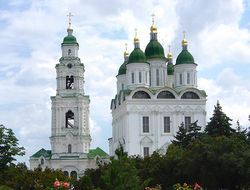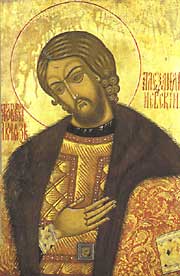Galitzine

The Golitsyns (Russian: Голи́цын), also commonly known as Galitzines, are one of the largest and noblest princely houses of Russia. Among many alternate spellings are Golitsin(a), Galitzin(a), Galytzin(a), and Galitsin(a). Since the extinction of the Korecki family in the 17th century, the Golitsyns have claimed dynastic seniority in the House of Gediminas.
Contents |
Origins
The family descends from a Lithuanian prince Yury Patrikeyevich, grandson of Narimantas. He emigrated to the court of Vasily I and married his sister. His children and grandchildren, such as Vassian Patrikeyev, were considered premier Russian boyars. One of them, Prince Mikhail Bulgakov, was nicknamed Galitsa for an iron glove he wore in the Battle of Orsha (1514). His great grandson Prince Vasily Golitsyn (+1619) was active during the Time of Troubles and went as an ambassador to Poland to offer the Russian crown to Prince Wladislaw.
Vasily Vasilyevich Galitzine
Prince Vasily Vasilyevich (1643–1714) was probably the greatest Russian statesman of the 17th century. He spent his early days at the court of Tsar Alexius where he gradually rose to the rank of boyar. In 1676 he was sent to Ukraine to keep in order the Crimean Tatars and took part in the Chigirin campaign. Personal experience of the inconveniences and dangers of the prevailing system of preferment; the so-called mestnichestvo, or rank priority, which had paralysed the Russian armies for centuries, induced him to propose its abolition, which was accomplished by Tsar Feodor III in 1678.

The May revolution of 1682 placed Galitzine at the head of the Posolsky Prikaz, or ministry of foreign affairs, and during the regency of Sophia, sister of Peter the Great, whose intimate friend he became, he was the principal minister of state (1682–1689) and keeper of the great seal, a title bestowed upon only two Russians before him, Afanasy Ordin-Nashchokin and Artamon Matveev. In home affairs his influence was insignificant, but his foreign policy was distinguished by the Treaty of Nerchinsk (1689), which set the Russo-Chinese border north of the Amur River, and by the peace with Poland (1683), whereby Russia at last recovered Kiev. By the terms of the same treaty, he acceded to the grand league against the Porte, but his two expeditions against the Crimea (Crimean campaigns of 1687 and 1689) were unsuccessful and made him extremely unpopular.
Only with the utmost difficulty could Sophia get the young tsar Peter to decorate the defeated commander-in-chief as if he had returned a victor. In the civil war between Sophia and Peter (August-September 1689), Galitzine half-heartedly supported his mistress and shared her ruin. His life was spared owing to the supplications of his cousin Boris, but he was deprived of his boyardom, his estates were confiscated and he was banished successively to Kargopol, Mezen and Kholmogory, where he died on 21 April, 1714.
Galitzine was unusually well educated. He was a great friend of foreigners, who generally alluded to him as the great Galitzine. He expounded to them some drastic reform measures, such as the abolition of serfdom, the promotion of religious toleration, and the development of industrial enterprises. As Galitzine was eager to avoid all forms of violence and repression, his program was more cautious and realistic than that of Peter the Great. Political upheavals prevented him from executing any of these plans.
Boris Alexeyevich Galitzine


Vasily's political adversary was his cousin Prince Boris Alexeevich (1654–1714), a court Chamberlain since 1676. He was the young tsar Peter's chief supporter when, in 1689, Peter resisted the usurpations of his elder sister Sophia, and the head of the loyal council which assembled at the Trinity monastery during the crisis of the struggle. It was Galitzine who suggested taking refuge in that strong fortress and won over the boyars of the opposite party.
In 1690 he was created a boyar and shared with Lev Naryshkin, Peter's uncle, the conduct of home affairs. After the death of the tsaritsa Natalia, Peter's mother, in 1694, his influence increased still further. He accompanied Peter to the White Sea (1694–1695); took part in the Azov campaign (1695); and was one of the triumvirat who ruled Russia during Peters first foreign tour (1697–1698). The Astrakhan rebellion (1706), which affected all the districts under his government, shook Peter's confidence in him, and seriously impaired his position. In 1707 he was superseded in the Volgan provinces by Andrei Matveev. A year before his death he entered a monastery.
Galitzine was a typical representative of Russian society of the end of the 17th century leaning towards Westernism. In many respects he was far in advance of his age. He was highly educated, spoke Latin with graceful fluency, frequented the society of scholars and had his children carefully educated according to the best European models. Yet this eminent, this superior personage was an habitual drunkard, an uncouth savage who intruded upon the hospitality of wealthy foreigners, and was not ashamed to seize upon any dish he took a fancy to, and send it home to his wife. It was his reckless drunkenness which ultimately ruined him in the estimation of Peter the Great, despite his previous inestimable services.
Dmitry Mikhaylovich Galitzine
The Great Galitzine had another cousin, Prince Dmitry Mikhaylovich (1665–1737), noted for his noble attempt to turn Russia into a constitutional monarchy. He was sent by Peter the Great in 1697 to Italy to learn military affairs; in 1704 he was appointed to the command of an auxiliary corps in Poland against Charles XII; from 1711 to 1718 he was governor of Belgorod. In 1718 he was appointed president of the newly erected Commerce Collegium and a senator. In May 1723 he was implicated in the disgrace of the vice-chancellor Shafirov and was deprived of all his offices and dignities, which he only recovered through the mediation of the empress.
After the death of Peter the Great, Galitzine became the recognized head of the old Conservative party which had never forgiven Peter for putting away Eudoxia and marrying the plebeian Martha Skavronskaya. But the reformers, as represented by Alexander Menshikov and Peter Tolstoi, prevailed; and Galitzine remained in the background till the fall of Menshikov, 1727. During the last years of Peter II (1728–1730), Galitzine was the most prominent statesman in Russia and his high aristocratic theories had full play.
On the death of Peter II he conceived the idea of limiting the autocracy by subordinating it to the authority of the Supreme privy council, of which he was president. He drew up a form of constitution which Anna of Courland, the newly elected Russian empress, was forced to sign at Mittau before being permitted to proceed to St Petersburg. Anna lost no time in repudiating this constitution, and never forgave its authors.

Galitzine was left in peace, however, and lived for the most part in retirement, till 1736, when he was arrested on suspicion of being concerned in the conspiracy of his son-in-law Prince Constantine Cantimir. This, however, was a mere pretext, it was for his anti-monarchical sentiments that he was really prosecuted. A court, largely composed of his antagonists, condemned him to death, but the empress reduced the sentence to lifelong imprisonment in Schlisselburg and confiscation of all his estates. He died in his prison on the 14th of April 1737, after three months of confinement.
Other notable Golitsyns
Dmitry's brother Mikhail (c.1674–1730) was a celebrated heroical soldier, 'prince valiant', who is best known for his governorship of Finland (1714–1721), where his magnanimous rule was remembered as noble and exemplary by the people he had conquered as the Greater Wrath (Swedish: Stora ofreden). General field marshal.
His younger brother, another Mikhail Mikhaylovich Golitsyn (1684-1764) was general admiral of the Russian fleet (1756)
And Mikhail's son Alexander Mikhaylovich (1718–1783) was a diplomat and soldier, who likewise rose to be field-marshal and governor of St. Petersburg.
Another son of Mikhail's, Dmitry Mikhaylovich (1721–1793), was the Russian ambassador in Vienna during the reign of Catherine the Great. Primarily remembered for the splendid Galitzine Hospital he opened in Moscow, he should also be noted as a great friend and patron of Mozart.
Another Alexander Mikhaylovich Golitsyn (1723-1804) son of general admiral Mikhail Mikhaylovich Golitsyn
Prince Dmitry Dmitriyevich Golitsyn (1770–1840), also known as the Apostle of the Alleghanies, was the first Roman Catholic priest ordained in America; a settlement in Pennsylvania is named after him. He is currently under investigation for possible Sainthood, his current title is Servant of God.

Prince Dmitri Vladimirovich Golitsyn (1771–1844) fought bravely during the Napoleonic wars, was promoted to the rank of Lieutenant General and governed Moscow for 25 years.
Prince Alexander Nikolayevich (1773–1844) was a reactionary minister of education in the government of Alexander I. He headed an investigation into masonic involvement in the Decembrist uprising of 1825 and served as the Chairman of the State Council from 1838 to 1841.
Prince Nikolay Borisovich (1794–1866) was an amateur cellist who commissioned Beethoven to write his last string quartets, sometimes called the Galitzin quartets.
Prince Alexey Vasilyevich (1832-1901) was a friend of Pyotr Ilyich Tchaikovsky. Like the composer, Golitsyn was homosexual; but unlike the composer, he lived openly with his lover, Nikolay Vasilyevich Masalitinov (d. 1884).[1]
Prince Grigory Sergeyevich Golitsin (1838—1907) was a general and the Governor of Transcaucasia in 1897-1904.
Prince Lev Sergeyevich (June 24, 1845 - January 8, 1916 (June 12, 1845 - December 26, 1915, Old Style)) was one of the founders of wine-making in Crimea. In his Crimean estate of Novyi Svet he built the first Russian factory of champagne wines. In 1889 the production of this winery won the Gold Medal at the Paris exhibition in the nomination for sparkling wines. He became the surveyor of imperial vineyards at Abrau-Dyurso in 1891.
Prince Boris Borisovich (1862–1916) was a prominent physicist who invented the first electromagnetic seismograph in 1906.
Prince Nikolay Dmitriyevich Golitsyn (1850–1925) was the last Tsarist prime minister of Russia, at the time of the February Revolution.
Sergei Golitsyn (1909-1989) wrote Memoirs of a Survivor: The Golitsyn Family in Stalin's Russia, a memoir of his experiences of the period from the start of the Revolution in 1917 to Russia's entry into World War II in 1941.
Princess Irene Galitzine (1916-2006) fashion designer.
Prince Georgy Sergeyevich Golitsyn (born 1935) is a Russian physicist noted for his research on the concept of nuclear winter.
Prince Leo Galitzine. Escaped from Soviet Russia during World War I, came to settle in Canada by 1932 when he was active in the mineral rush to Great Bear Lake, Northwest Territories, the site of a silver and radium boom town. Galitzine, together with his wife Princess, bought an airplane and started a charter company at Great Bear Lake. By 1933, Galitzine was living in Edmonton, Alberta.
Prince George Golitzin was the associate producer for Pollyanna and Parent Trap. His brother, Prince Alexander Golitzen was art director for hundreds of movies. He also built the sets for many an award ceremony.
Prince George's children are Alexander, John, Katherin and George. Father Alexander Golitzin, [1] is an Orthodox priest, monk, patristic scholar and professor of theology at Marquette University in Milwaukee, Wisconsin, whose work focus on the discerning the roots of eastern Christian spirituality in Second Temple Judaism. John Golitzin was an opera singer, now deceased. George Golitzin received his bachelors in Mathematics from Harvard University and PhD in Mathematics from Yale university, specializing in Algebraic Number Theory. [2]

.
Prince Vincent Blagoïevitch Golitsyn (1970), President of Ekkoil. Advisor in communication political, and geopolitical, near the Russian Prime Minister Vladimir Putin.
References
- ↑ Alexander Poznansky, Tchaikovsky: The Quest for the Inner Man, many refs
 This article incorporates text from a publication now in the public domain: Chisholm, Hugh, ed (1911). Encyclopædia Britannica (Eleventh ed.). Cambridge University Press.
This article incorporates text from a publication now in the public domain: Chisholm, Hugh, ed (1911). Encyclopædia Britannica (Eleventh ed.). Cambridge University Press.
External links
|
|||||||||

.jpg)